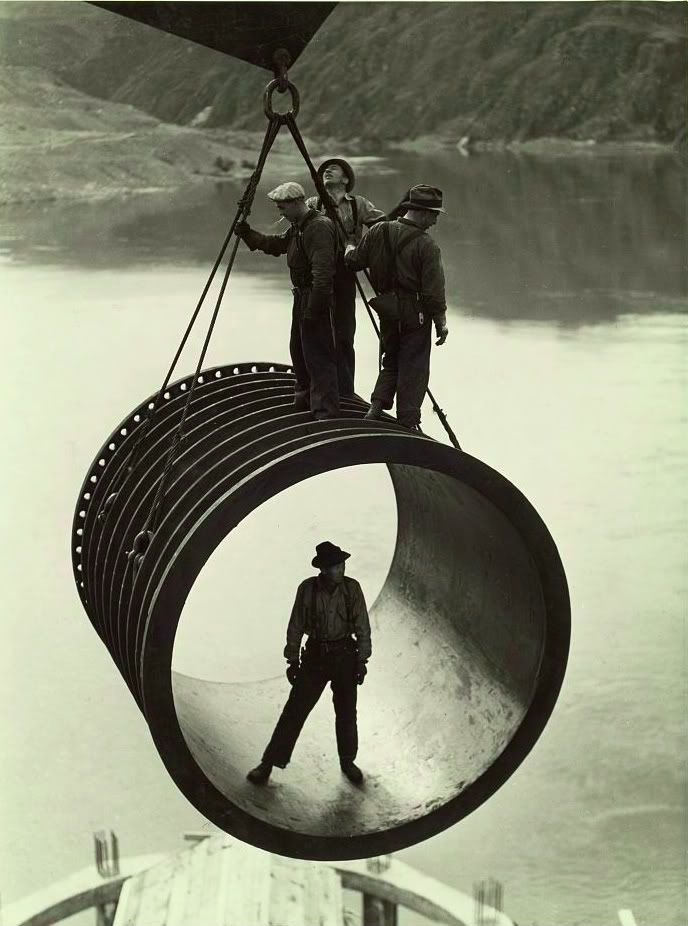 Photograph from the U.S. Bureau of Reclamation showing a casing section of pipe suspended by cable, as it is moved into position by a crane during construction of the Grand Coulee Dam, Washington.
Photograph from the U.S. Bureau of Reclamation showing a casing section of pipe suspended by cable, as it is moved into position by a crane during construction of the Grand Coulee Dam, Washington.The U.S. Bureau of Reclamation, an agency of the Department of the Interior, is one of the main water management agencies of the United States government. Set up after Congress passed the Reclamation Act of 1902, its aim was to reclaim the desert areas of the seventeen western states for settlement through the development of irrigated agriculture.
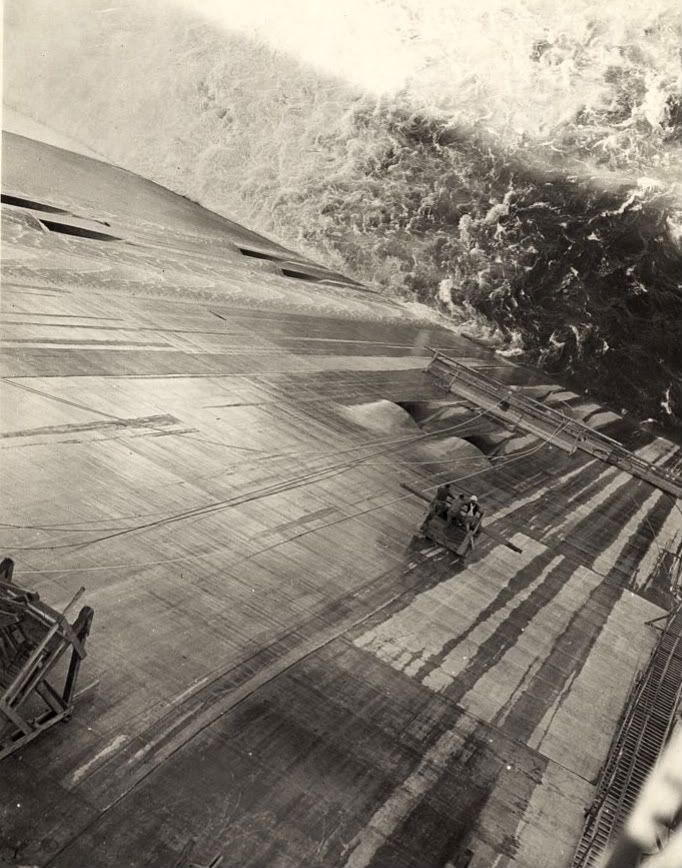 Photograph by F.B. Pomeroy: Grand Coulee Dam, Columbia Basin Reclamation Project; Looking down the face of the dam from the roadway on top. Men are riding a skip to the area to be repaired. September 1942.
Photograph by F.B. Pomeroy: Grand Coulee Dam, Columbia Basin Reclamation Project; Looking down the face of the dam from the roadway on top. Men are riding a skip to the area to be repaired. September 1942.
The United States Reclamation Service, as it was then named, studied and applied potential water development projects in the western states. Between 1902 and 1907 the bureau of set up and managed around 30 projects in western states area. By 1923 however, increasing unrest among the settlers and budgetary problems were becoming increasing problematic for the fledgling agency. As it became more apparent that reorganisation of the service was needed, its name was changed from the United States Reclamation Service, to The Bureau Of Reclamation (reclamation meaning irrigation) and it was moved from the U.S.G.S and placed under the management of The Department Of The Interior.
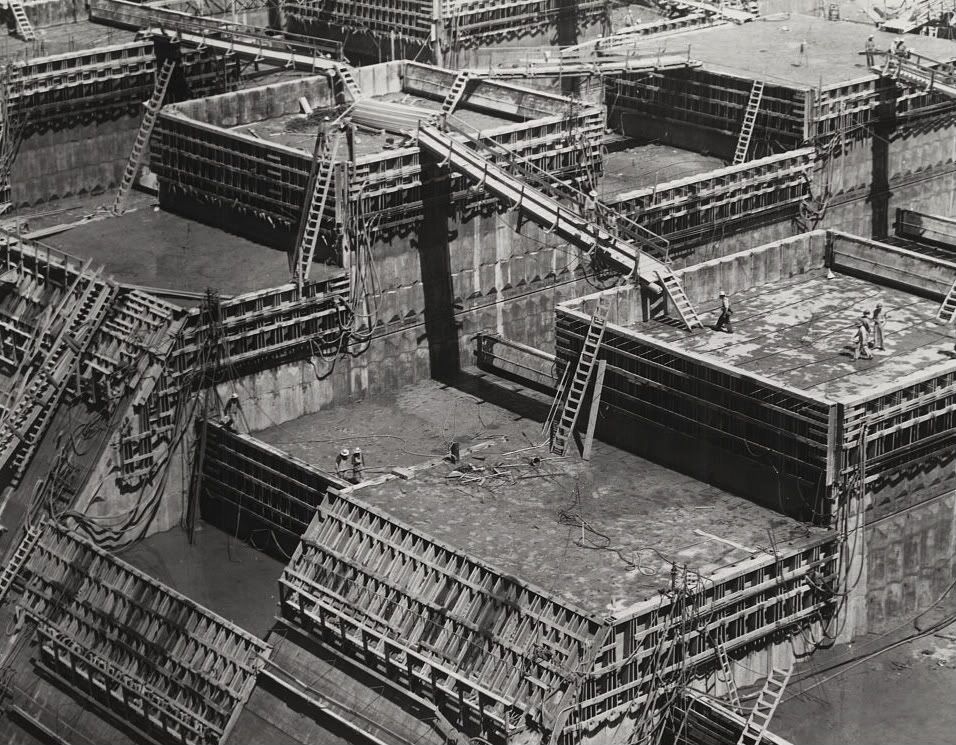 Rows 27 to 29 of the Shasta Dam on downstream face, as seen from left abutment.1935-40.
Rows 27 to 29 of the Shasta Dam on downstream face, as seen from left abutment.1935-40.
This started the boom years for the Bureau of Reclamation, under the New Deal programs, the agency was reorganised. As the programmes managed by the bureau developed, it became clear that reclamation dams and reservoirs could be further evolved and developed to meet other parallel needs, such as flood control, municipal water supply, and hydroelectric power generation.
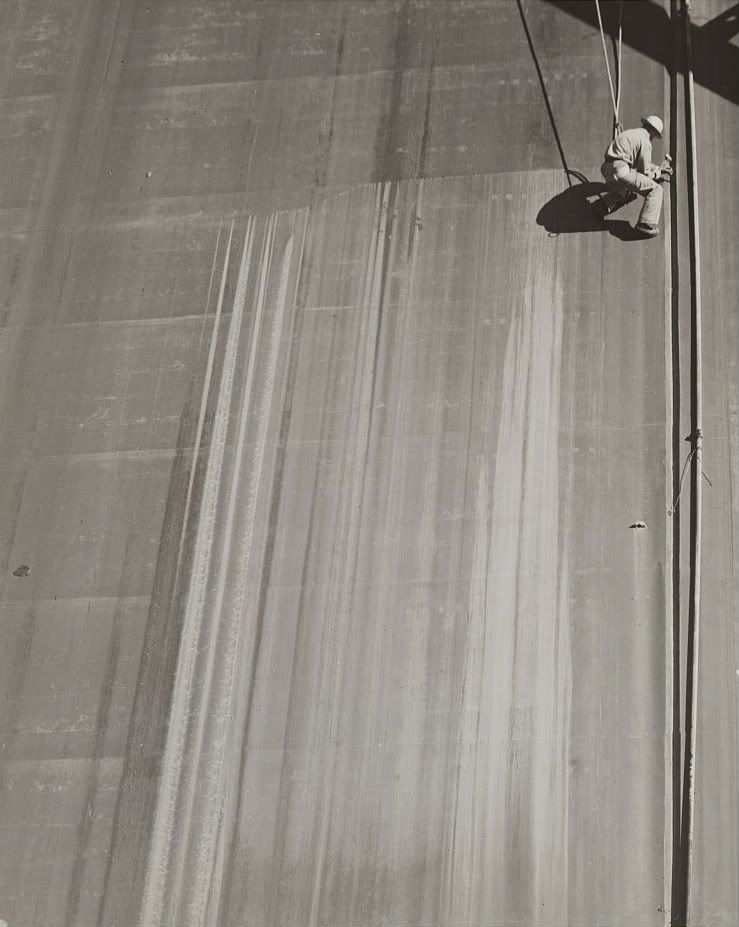 The dam gets a facial: Worker suspended by ropes "removing spilled concrete, water stains, grout streaks, and other blemishes" on the downstream face of the Friant Dam, California 1936-46.
The dam gets a facial: Worker suspended by ropes "removing spilled concrete, water stains, grout streaks, and other blemishes" on the downstream face of the Friant Dam, California 1936-46.
Central Valley Reclamation Project, Calif. Pier 11, spillway section of the Keswick Dam, as seen from a point downstream. September 1942.
The construction of the Hoover Dam under The Central Valley Project in California, and the Grand coulee dam under the Columbia Basin Project, perhaps marked the high point for the large scale construction projects undertaken by the bureau.
 View of Hiwassee Dam and powerhouse.1936-1940.
View of Hiwassee Dam and powerhouse.1936-1940.
Photograph by: F.B. Pomeroy .U.S. Bureau of Reclamation: A steel worker working on a section of the Grand Coulee Dam east powerhouse, June 1942.
During World War II, many of the large scale projects were scaled back, but between 1941–1947 labour provided by the Civilian Public Service allowed the bureau to restart many of the projects interrupted for the war effort.
 Tennessee Valley Authority: Workmen in the dam powerhouse installing a generator, Norris Dam, Tennessee. 1935-40.
Tennessee Valley Authority: Workmen in the dam powerhouse installing a generator, Norris Dam, Tennessee. 1935-40.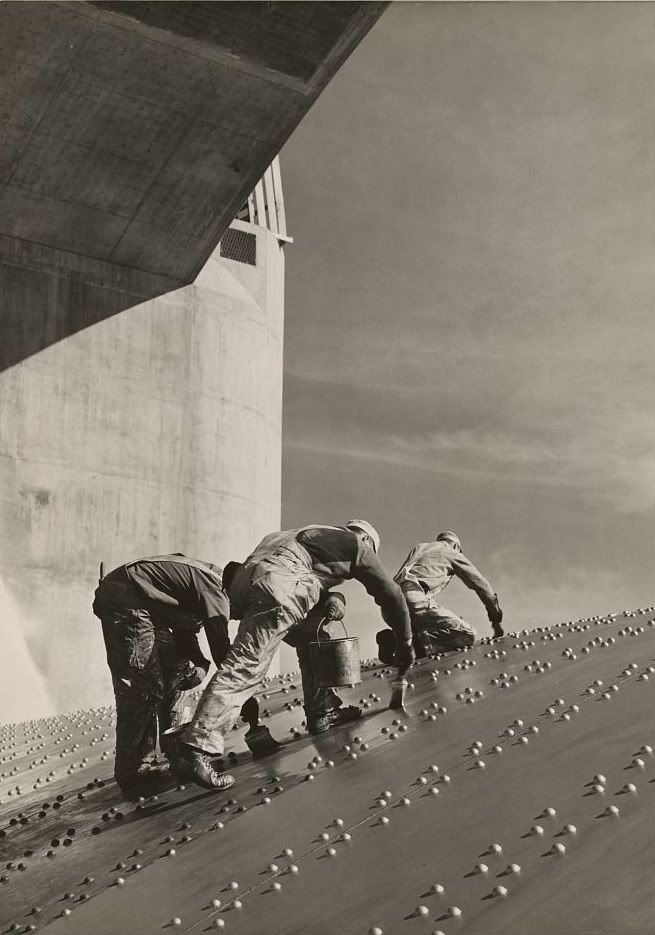 Three construction workers putting a coat of paint on a slanted wall of riveted-steel plates on the Hoover Dam spillway between 1936 and 1946
Three construction workers putting a coat of paint on a slanted wall of riveted-steel plates on the Hoover Dam spillway between 1936 and 1946By the 1960's the construction phase was beginning to slow as many of the large projects conceived to help "tame" the rivers and lakes of the west were completed, indeed by the 1980's the bureau was again undertaking major reorganization with a new redefined official mission to "manage, develop, and protect water and related resources in an environmentally and economically sound manner in the interest of the American public".
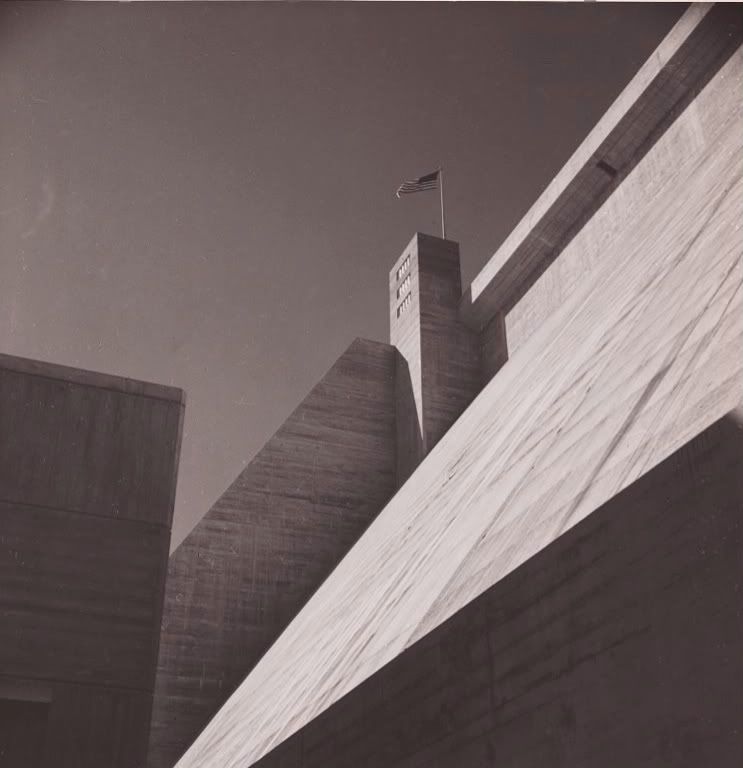 Photograph by Barbra Wright: Exterior wall of dam from below, with flag pole and American flag 1941.
Photograph by Barbra Wright: Exterior wall of dam from below, with flag pole and American flag 1941.
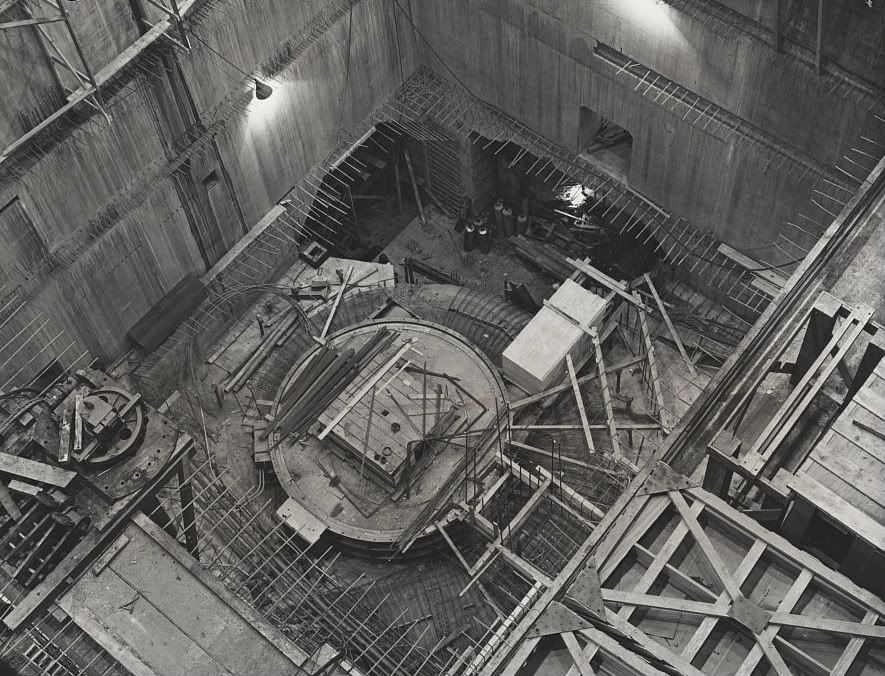
Columbia Basin Project, Grand Coulee Dam. Photograph showing construction on the turbine pit at the Grand Coulee Dam, Washington. December 1942.
This was the final switch from construction, to maintenance and management of the water systems in the western states. The Bureau of Reclamation now operates about 180 projects in the 17 western states. These projects provide agricultural, household, and industrial water to about one-third of the population of the American West. The Bureau Of Reclamation provides water to about 9,120,000 acres (37,000 km²) of farmland, and has constructed more than 600 dams and reservoirs including the Hoover and Coulee dams. It runs 58 hydroelectric power plants and produces enough hydro electricity to serve 6 million homes.
 Central Valley Reclamation Project, Kennett Division: Shasta Dam cable way head tower California 1940.
Central Valley Reclamation Project, Kennett Division: Shasta Dam cable way head tower California 1940.
 Three construction workers, suspended by ropes, with pneumatic hammers cutting into a mountain, during construction of the Grand Coulee Dam, Columbia River, Washington 1936- 1946.
Three construction workers, suspended by ropes, with pneumatic hammers cutting into a mountain, during construction of the Grand Coulee Dam, Columbia River, Washington 1936- 1946.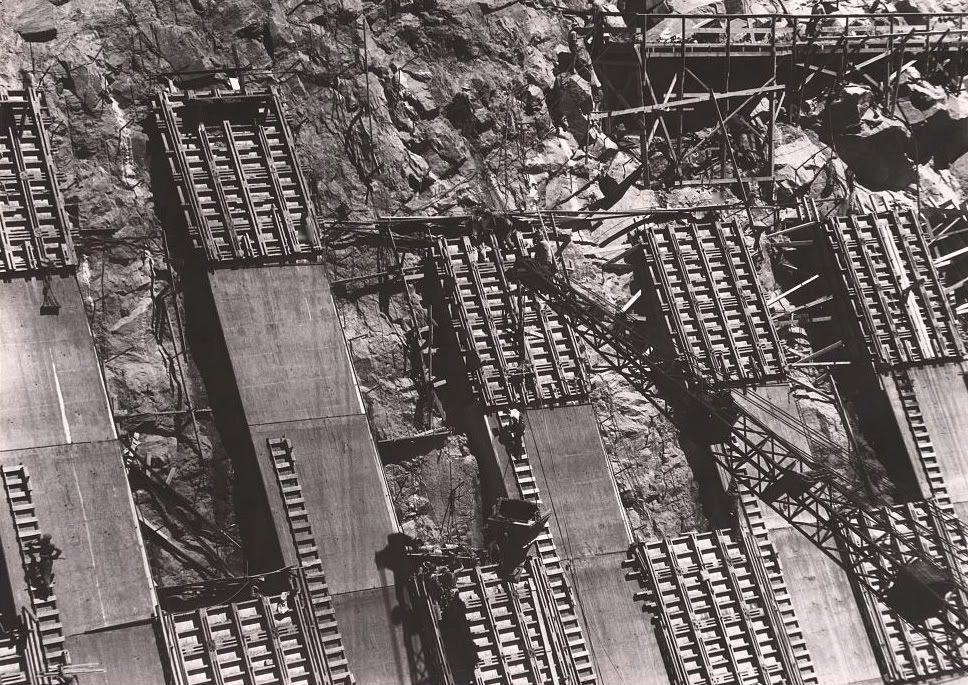 Boulder Dam, (i.e. Hoover Dam): Placing concrete in the sidewall of the Nevada spillway. Note the manner in which the panels are staggered, June 1933. (Early plans called for the dam to be built in Boulder Canyon, so the project was known as the Boulder Canyon Project. The dam site was eventually moved downstream eight miles to Black Canyon, but the project name remained)
Boulder Dam, (i.e. Hoover Dam): Placing concrete in the sidewall of the Nevada spillway. Note the manner in which the panels are staggered, June 1933. (Early plans called for the dam to be built in Boulder Canyon, so the project was known as the Boulder Canyon Project. The dam site was eventually moved downstream eight miles to Black Canyon, but the project name remained) 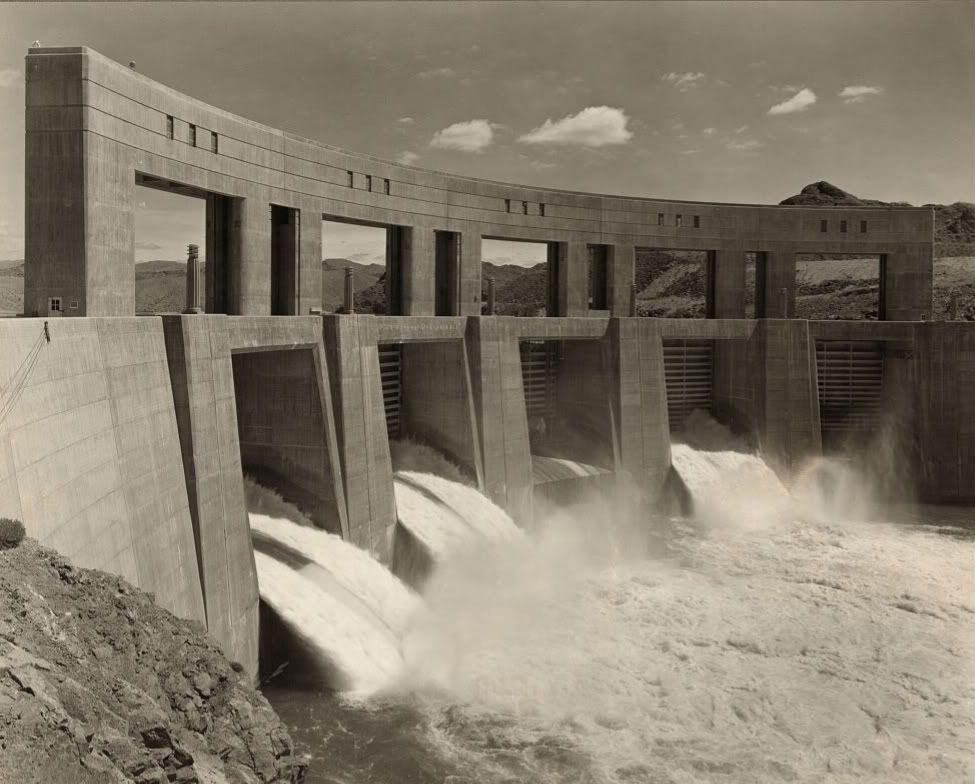 The Parker Dam power project, Arizona and California. View of Parker Dam from the California side 1941.
The Parker Dam power project, Arizona and California. View of Parker Dam from the California side 1941.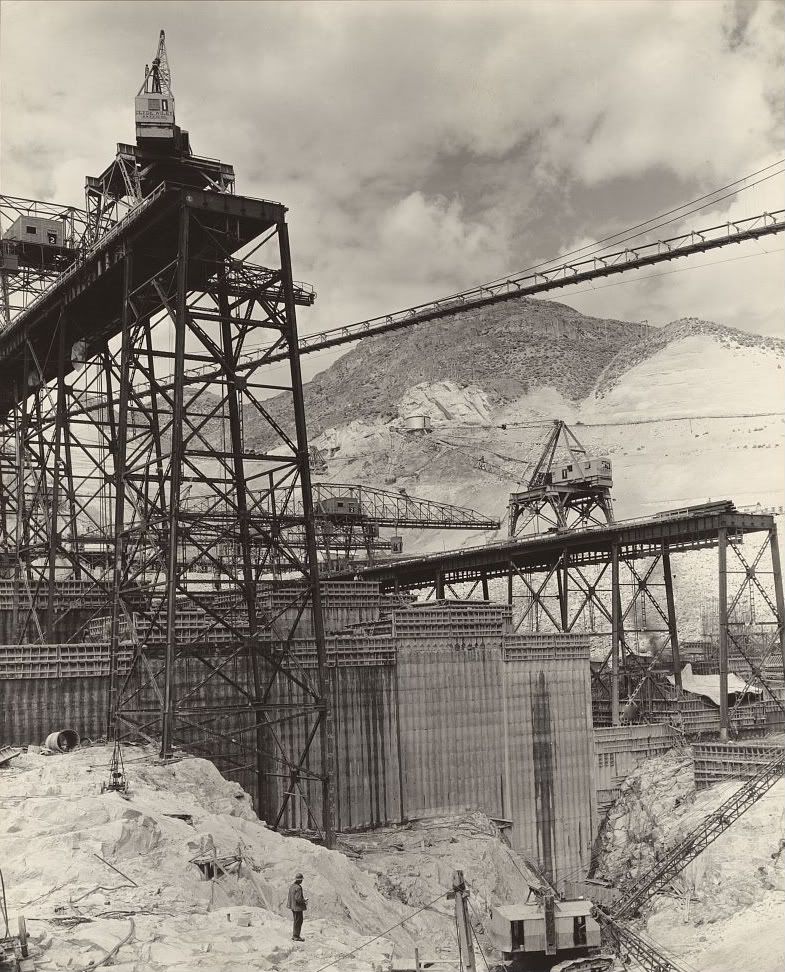 The Grand Coulee Dam, Columbia Basin Reclamation Project: The east face of block 31 with a portion of the deep crevice shown in the foreground showing the high trestle.
The Grand Coulee Dam, Columbia Basin Reclamation Project: The east face of block 31 with a portion of the deep crevice shown in the foreground showing the high trestle.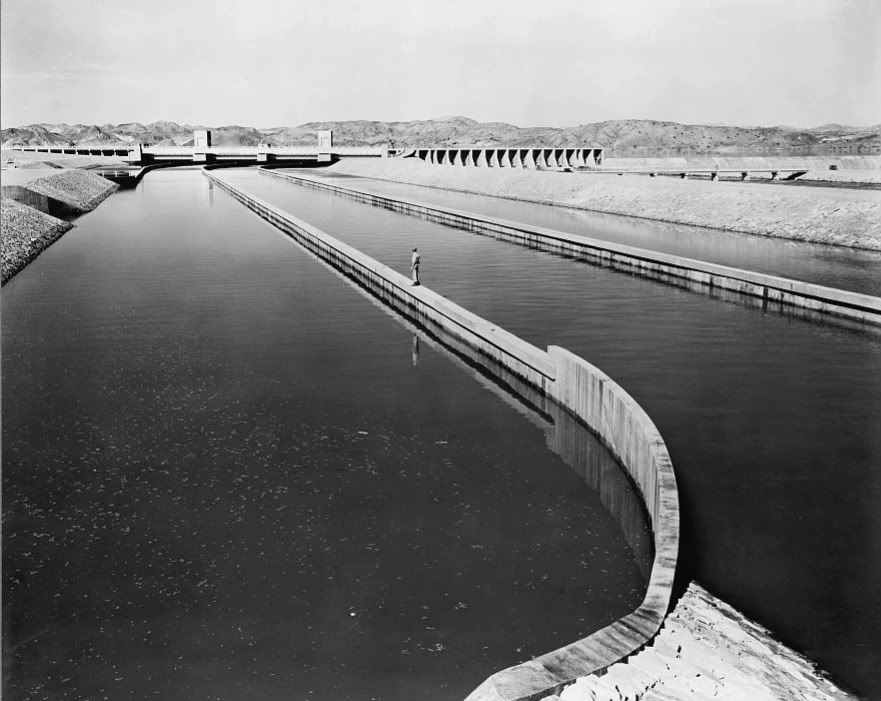 The All American Canal Project, Imperial Dam, channels 2-4, California and Arizona. February 1939.
The All American Canal Project, Imperial Dam, channels 2-4, California and Arizona. February 1939.
 Chickamauga Dam and powerhouse: View of Chickamauga spillway floodlighted at night, from visitors' overlook terrace at powerhouse. 1933 and 1945.
Chickamauga Dam and powerhouse: View of Chickamauga spillway floodlighted at night, from visitors' overlook terrace at powerhouse. 1933 and 1945. All the photographs in this collection are courtesy of the Office of war information and Bureau Of Reclamation collection at the Library Of Congress.
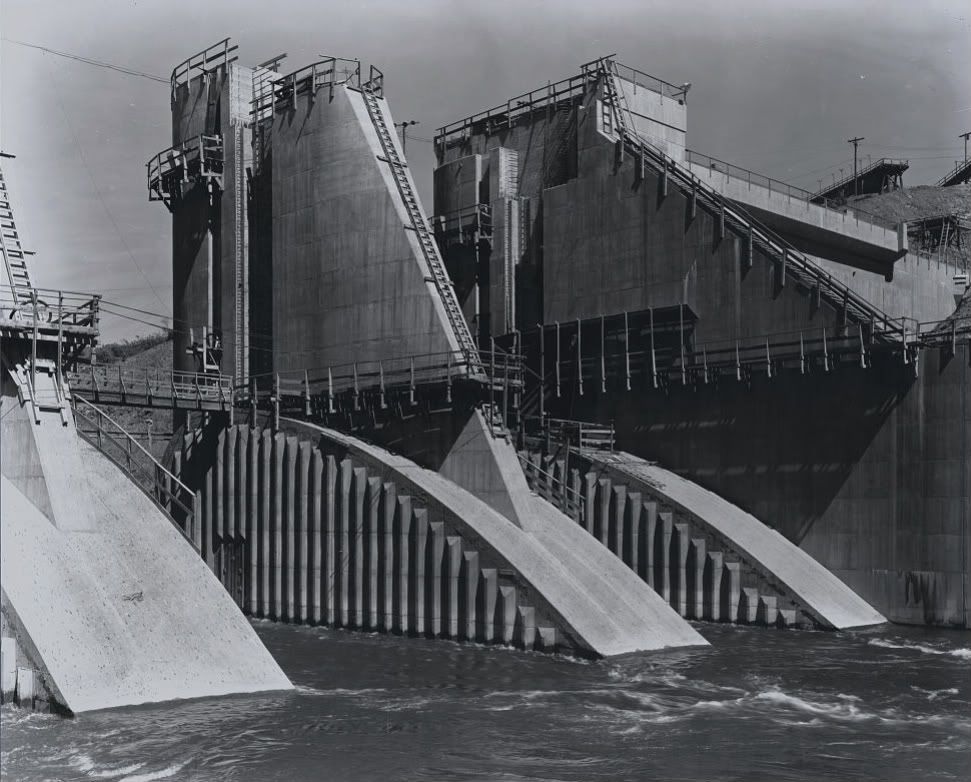
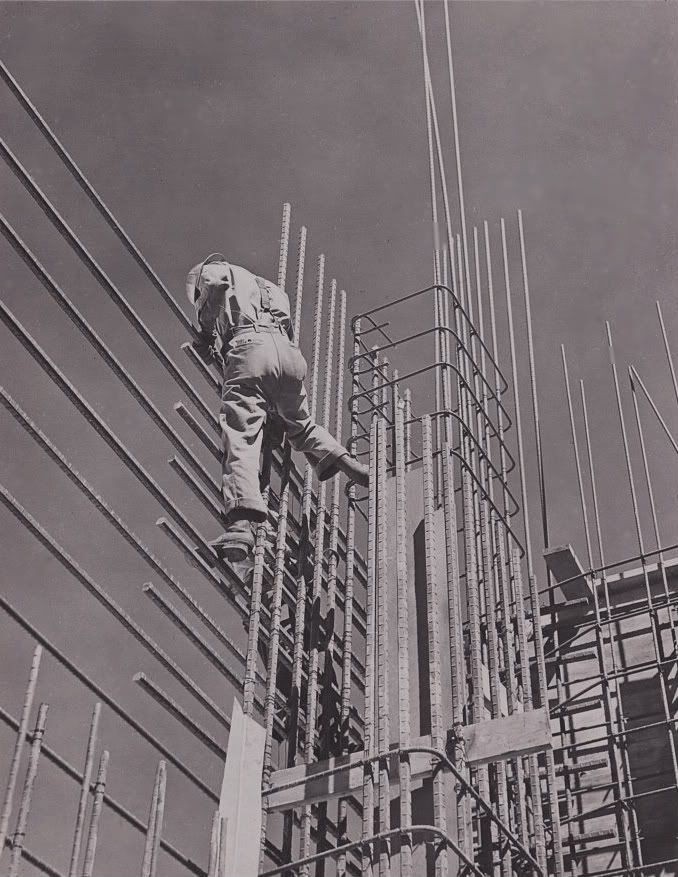




No comments:
Post a Comment